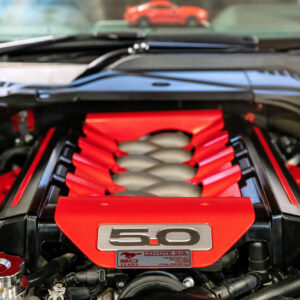Is bigger really better? It’s a simple yes or no question, but it gets a little more complicated when it comes to engines. A big block engine is known to be much bigger than a small block engine, but does that also mean it’s better than its smaller counterpart?
What Is a Big Block Engine?
A big block engine is exactly what it sounds like: a big engine with big bores, big valves, and big ports. It can produce much more power than a small block engine, making it the popular choice for larger cars and trucks before it eventually found its way into passenger vehicles.
History of Big Block Engines
In 1958, Chevrolet released the first big block engines in the market known as the Mark I or W series to meet the increasing demand for bigger passenger vehicles after World War II.
Big block engines were a huge hit among muscle car fans, and it didn’t take long for Chevrolet to develop other versions of the big block, such as the 396, 427, and 454. Other manufacturers followed suit with their own big block engines, most notably Ford and Chrysler.
As popular as they were in their heyday, the last of the true Chevy big block engines called the Vortec 8100 was discontinued in 2009 after emission regulations tightened.

Differences Between Big Block and Small Block Engines
Did you know big block and small block engines don’t just differ in size? Their size is definitely the most obvious difference, but they differ in a few other areas too. Here are some examples:
Displacement
How do you measure the power of an engine? While displacement isn’t a direct measure of power, it’s certainly a good place to start. Displacement refers to the measurement of the volume of an engine’s pistons, and the greater the displacement value, the more air and fuel a vehicle can take in.
Small block engines typically have a displacement of less than 400 cubic inches, while most big block engines can reach around 430 cubic inches. This means big block engines can take in more air and fuel to generate more power.

Bore and Stroke
To determine an engine’s displacement, you’ll have to measure two other factors: the engine’s bore and stroke. Big block engines typically have larger bores and shorter strokes than small block engines, which means they have greater efficiency and displacement. This also means great engine performance even at high speeds.
Size and Shape
Of course, the fastest and easiest way to tell these two engines apart is by simply looking at them. A big block engine is physically larger than a small block engine, and it usually comes in a “Y” shape because of all that extra space in between the cylinders.
Pros of Big Block Engines
A lot of people say bigger is better, but what exactly are the advantages that make big block engines better than small blocks?
More Power
When people talk about big block engines, they never fail to mention how powerful they are. Big block engines usually have bigger cylinders than small blocks, so they’re capable of generating power with ease.
More Torque
All that extra power and weight also means big block engines produce more torque, allowing the vehicle to accelerate harder while gaining more traction.
Cons of Big Block Engines
Unfortunately, big block engines are far from perfect. They come with their fair share of disadvantages too, such as the following:
Heavier
One of the major drawbacks of having a big size is all that extra weight. Big block engines are known to sit lower in most vehicles, giving them a lower center of gravity. Unfortunately, this also means big block engines add a few pounds to the front axle, which can negatively affect handling and acceleration.
Consumes More Fuel
Owning a vehicle with a big block engine means more power, yes, but it also means you’ll end up spending more money on gas. Because big block engines produce more power, they also burn through fuel much faster than smaller engines.
More Expensive To Fix
Known to handle higher revolutions per minute (RPM), big block engines are often pushed to the extreme. All that heavy lifting makes them a lot more prone to engine damage than smaller engines, which can cost you thousands of dollars to repair.
Vehicles With a Big Block Engine
It’s certainly been a long time since the last big block hit the market, but the demand for them is still high within the classic car community. Some of the most popular vehicles with a big block engine are the following:
- 1967 Chevrolet Camaro 427
- 1967 Mustang Shelby GT500
- 1966 Plymouth Satellite
- 1969 Dodge Charger R/T
- 1970 Chevrolet Chevelle
Despite their massive popularity in the 1960s, muscle cars with big block engines have all been discontinued. You can still find some of these vintage muscle cars on the market.
Big Block vs. Small Block: Which Engine Is for You?
At the end of the day, it all depends on what you’re looking for. If you’re on a budget, then a small block engine is probably the best option for you right now. However, if you’re in the market for a big and powerful engine, then a big block engine is the way to go.
Keep in mind that most manufacturers have completely phased out their big block engines, so you won’t find a new one on the market. Still, there are plenty of used vehicles with big block engines being sold online that are also in great condition.
Any information provided on this Website is for informational purposes only and is not intended to replace consultation with a professional mechanic. The accuracy and timeliness of the information may change from the time of publication.






























